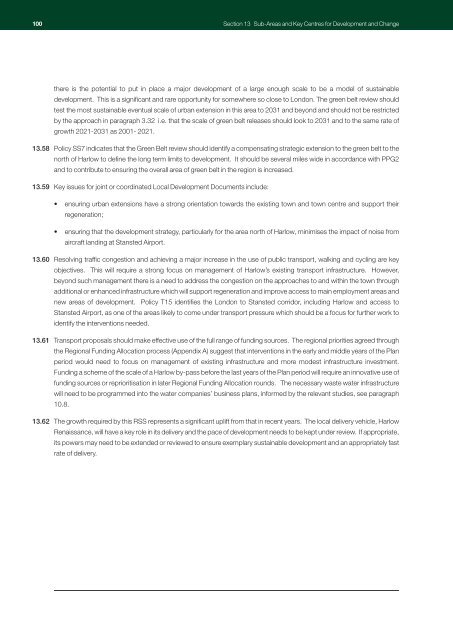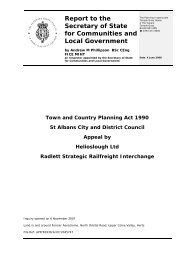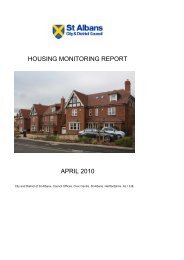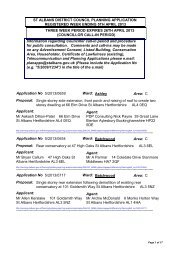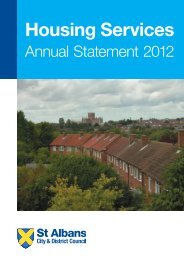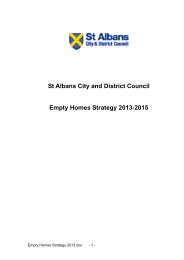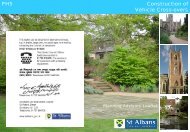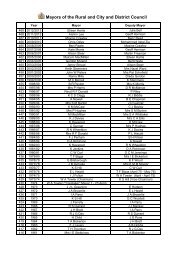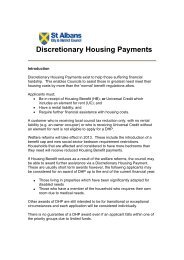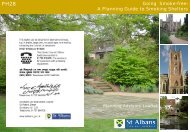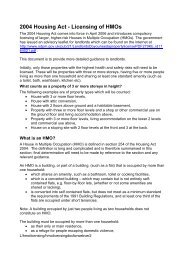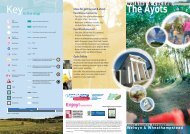RSS East Of England Plan - Broads Authority
RSS East Of England Plan - Broads Authority
RSS East Of England Plan - Broads Authority
You also want an ePaper? Increase the reach of your titles
YUMPU automatically turns print PDFs into web optimized ePapers that Google loves.
100<br />
Section 13 Sub-Areas and Key Centres for Development and Change<br />
there is the potential to put in place a major development of a large enough scale to be a model of sustainable<br />
development. This is a significant and rare opportunity for somewhere so close to London. The green belt review should<br />
test the most sustainable eventual scale of urban extension in this area to 2031 and beyond and should not be restricted<br />
by the approach in paragraph 3.32 i.e. that the scale of green belt releases should look to 2031 and to the same rate of<br />
growth 2021-2031 as 2001- 2021.<br />
13.58 Policy SS7 indicates that the Green Belt review should identify a compensating strategic extension to the green belt to the<br />
north of Harlow to define the long term limits to development. It should be several miles wide in accordance with PPG2<br />
and to contribute to ensuring the overall area of green belt in the region is increased.<br />
13.59 Key issues for joint or coordinated Local Development Documents include:<br />
• ensuring urban extensions have a strong orientation towards the existing town and town centre and support their<br />
regeneration;<br />
• ensuring that the development strategy, particularly for the area north of Harlow, minimises the impact of noise from<br />
aircraft landing at Stansted Airport.<br />
13.60 Resolving traffic congestion and achieving a major increase in the use of public transport, walking and cycling are key<br />
objectives. This will require a strong focus on management of Harlow’s existing transport infrastructure. However,<br />
beyond such management there is a need to address the congestion on the approaches to and within the town through<br />
additional or enhanced infrastructure which will support regeneration and improve access to main employment areas and<br />
new areas of development. Policy T15 identifies the London to Stansted corridor, including Harlow and access to<br />
Stansted Airport, as one of the areas likely to come under transport pressure which should be a focus for further work to<br />
identify the interventions needed.<br />
13.61 Transport proposals should make effective use of the full range of funding sources. The regional priorities agreed through<br />
the Regional Funding Allocation process (Appendix A) suggest that interventions in the early and middle years of the <strong>Plan</strong><br />
period would need to focus on management of existing infrastructure and more modest infrastructure investment.<br />
Funding a scheme of the scale of a Harlow by-pass before the last years of the <strong>Plan</strong> period will require an innovative use of<br />
funding sources or reprioritisation in later Regional Funding Allocation rounds. The necessary waste water infrastructure<br />
will need to be programmed into the water companies’ business plans, informed by the relevant studies, see paragraph<br />
10.8.<br />
13.62 The growth required by this <strong>RSS</strong> represents a significant uplift from that in recent years. The local delivery vehicle, Harlow<br />
Renaissance, will have a key role in its delivery and the pace of development needs to be kept under review. If appropriate,<br />
its powers may need to be extended or reviewed to ensure exemplary sustainable development and an appropriately fast<br />
rate of delivery.


